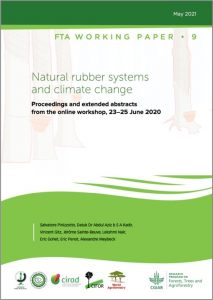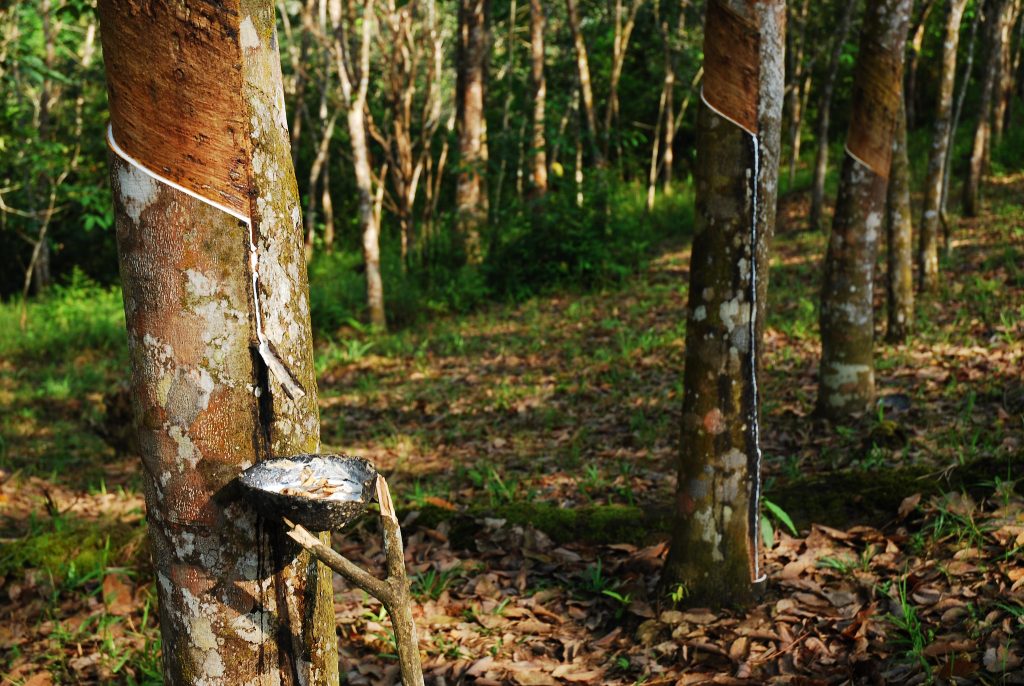FTA, together with the International Rubber Study Group (IRSG), the International Rubber Research and Development Board (IRRDB), the Center for International Forestry Research (CIFOR), and the French Agricultural Research Centre for International Development (CIRAD), just released the proceedings and extended abstracts of the digital workshop on natural rubber systems and climate change organized on 23-25th June 2020. Video recordings of all the sessions from the workshop can be streamed below.

Natural rubber is a key global commodity, above 85% produced by small-holder farmers. As recalled by Datuk Dr Abdul Aziz S.A. Kadir, Secretary General of the IRRDB, “Natural rubber sustains 13 million small holders and 40 million people including their families”. It has a great potential to contribute to sustainable development, both poverty alleviation and rural development, and to the bio-economy. However, as emphasized by Jerome Sainte Beuve, Rubber Value Chain Correspondent, CIRAD “climate change is already impacting rubber production”. As stated by Dr Vincent Gitz, Director of FTA, “Natural rubber has a key role to play for both adaptation and mitigation of climate change”. There is an urgent need to understand how global natural rubber production can be safeguarded and sustainably increased on a lasting basis under climate change, while contributing to climate mitigation goals.
Salvatore Pinizzotto, Secretary General of the IRSG emphasized that “Climate action needs to be grounded on science, on a common understanding of issues and means to address them”.
This is why the International Rubber Study Group (IRSG), with the International Rubber Research and Development Board (IRRDB), the CGIAR research program on Forests, Trees and Agroforestry (FTA) led by the Center for International Forestry Research (CIFOR), and the French Agricultural Research Centre for International Development (CIRAD), organized an open digital workshop on natural rubber systems and climate change on 23-25th June 2020.
The workshop reviewed recent research results on impacts of climate change on natural rubber production, potential means of adaptation and contribution to mitigation of climate change, to identify knowledge and research gaps as well as recommendations for action.
The workshop considered:
- the impact of climate change on natural rubber systems and potential changes in the geography of production (session 1)
- the role of natural rubber systems for climate mitigation and adaptation (session 2)
- the integration of natural rubber systems in the broad perspective of climate change and sustainability policies (session 3) and in the international discussions on climate change (session 4)
and reflected on a way forward for the sector (session 5).
Natural rubber is a strategic raw material essential for human being mobility, welfare and safety. Furthermore, it is a resource of economic prosperity for many countries and communities worldwide. IRSG, together with CIFOR/FTA, CIRAD and IRRDB believes that there is no time to wait for the rubber sector and industry to initiate actions, together. This workshop, by reviewing existing knowledge, identifying gaps and bringing relevant information to the climate change community and to decision makers can play a major role in raising the visibility of natural rubber and its responses to climate change challenges.

The first session (divided in 3 sub-sessions) reviewed the state of knowledge about climate change impacts on natural rubber production systems, now and in the future. Rubber production is already impacted by increased variability, droughts, changes in rain patterns, extreme events. Little is known on potential effects of higher average temperatures on the physiology of rubber trees and thus on latex flows. Of particular concern are also increased risks of fungal attacks. The impacts of climate change are different in the different natural rubber producing regions, with potential effects on geographical distribution. There are a lot of useful results from the research conducted these last 10-15 years with important findings for adaptation through management and breeding for traditional as well as marginal areas.
Session 2 (divided in 2 sub-sessions) considered how can rubber contribute to climate change mitigation and the role of rubber systems for adaptation. Two types of complementary strategies are available for adaptation of rubber cultivation to climate change: improved Hevea genetic resources, and climate-resilient agronomic practices. Regarding breeding, the use of modern technologies and new genomic selection methods, such as genomic marker assisted selection, can fast forward the development of climate-resilient, high yielding clones, with an optimized use of the germplasm (looking especially to other Hevea species). International cooperation is key, for multinational clone exchanges and for testing. Going forward, this also raises many R&D avenues on improved land management through optimized agricultural practices including agroforestry, integrating carbon offsets into the rubber plantation economy, as well as new downstream applications of natural rubber as a green substitute to synthetic rubber.
Session 3 considered the Opportunities for better integrating natural rubber in broad Climate Change and Sustainability Policies, including Economic and Social Dimensions. Natural rubber, as a renewable material, and because of its contribution to the livelihoods of millions of small holders has a considerable potential to contribute to sustainable development in its three dimensions, economic, social and environmental. It offers a good opportunity to be part of future economic development trends towards a circular, forest-products based bioeconomy. It is a natural product with many positive characteristics which make it an essential part of plastic substitution and future uses in industry, textiles/footwear, and construction. Mechanims in place in other tree-commodity sectors, reviewed at the workshop, can provide starting points to develop similar initiatives for the rubber sector to strengthen sustainable production and consumption.
Session 4, titled “Rubber and Climate Change in the International Fora” explored the possible pathways to raise the importance of the rubber sector at international level in relation to Climate Change. A strong partnership among stakeholders in the natural rubber value chain can bring discussion on integration of rubber in mitigation policies, measures, and adaptation policies in the wider climate dialogues.
In session 5, the final panel, building upon the findings of the previous sessions, discussed a way forward for the sector to fully tackle climate-change related challenges. Natural rubber has a key role to play for both adaptation and mitigation of climate change. It is an important land user, a producer of renewable materials (rubber and wood), a major economic activity in many countries, supporting the livelihoods of millions of small holders. However, this role is not properly accounted for. The participating organizations are calling to build upon the workshop to construct a follow-up agenda on natural rubber systems and climate change. They are now bringing the related issues to the awareness of a greater range of stakeholders, including climate policy makers. Part of this goes by bringing rubber as a discussion topic to the UNFCCC.
The document:
This article was produced by the CGIAR Research Program on Forests, Trees and Agroforestry (FTA). FTA is the world’s largest research for development program to enhance the role of forests, trees and agroforestry in sustainable development and food security and to address climate change. CIFOR leads FTA in partnership with ICRAF, The Alliance of Bioversity and CIAT, CATIE, CIRAD, INBAR and TBI. FTA’s work is supported by the CGIAR Trust Fund.











